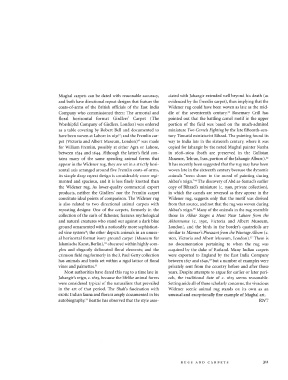Page 327 - Decorative Arts, Part II: Far Eastern Ceramics and Paintings, Persian and Indian Rugs and Carpets
P. 327
Mughal carpets can be dated with reasonable accuracy, ciated with Jahangir extended well beyond his death (as
and both have directional repeat designs that feature the evidenced by the Fremlin carpet), thus implying that the
coats-of-arms of the British officials of the East India Widener rug could have been woven as late as the mid-
Company who commissioned them: The armorial and dle of the seventeenth century. 23 Rosemary Crill has
floral horizontal format Girdlers' Carpet (The pointed out that the battling camel motif in the upper
Worshipful Company of Girdlers, London) was ordered portion of the field was based on the much-admired
as a table covering by Robert Bell and documented to miniature Two Camels Fightingby the late fifteenth-cen-
17
have been woven at Lahore in i63i ; and the Fremlin car- tury Timurid miniaturist Bihzad. The painting found its
18
pet (Victoria and Albert Museum, London) was made way to India late in the sixteenth century, where it was
for William Fremlin, possibly at either Agra or Lahore, copied for Jahangir by the noted Mughal painter Nanha
between 1634 and 1644. Although the latter's field con- in 1608-1609 (both are preserved in the Gulistan
tains many of the same speeding animal forms that Museum, Tehran, Iran, portion of the Jahangir Album). 24
appear in the Widener rug, they are set in a strictly hori- It has recently been suggested that the rug may have been
zontal axis arranged around five Fremlin coats-of-arms, woven late in the sixteenth century because the dynamic
its simple drop repeat design is considerably more regi- animals "seem closer to the mood of painting during
25
mented and spacious, and it is less finely knotted than Akbar's reign." The discovery of Abd as-Samad's earlier
the Widener rug. As lower-quality commercial export copy of Bihzad's miniature (c. 1590, private collection),
products, neither the Girdlers' nor the Fremlin carpet in which the camels are reversed as they appear in the
constitute ideal points of comparison. The Widener rug Widener rug, suggests only that the motif was derived
is also related to two directional animal carpets with from that source, and not that the rug was woven during
26
repeating designs: One of the carpets, formerly in the Akbar's reign. Many of the animals in the rug resemble
collection of the earls of Ilchester, features mythological those in Akbar Stages a Hunt Near Lahore from the
and natural creatures who stand out against a dark blue Akbarnama (c. 1590, Victoria and Albert Museum,
ground ornamented with a noticeably more sophisticat- London), and the birds in the border's quatrefoils are
19
ed vine system ; the other depicts animals in an unusu- similar to Mansurs Pheasant from the Wantage Album (c.
27
al horizontal format ivory ground carpet (Museum fur 1620, Victoria and Albert Museum, London). There is
20
Islamische Kunst, Berlin), obscured within highly com- no documentation pertaining to when the rug was
plex and elegantly delineated floral elements; and the acquired by the duke of Rutland. Many Indian carpets
crimson field rug formerly in the J. Paul Getty collection were exported to England by the East India Company
28
has animals and birds set within a rigid lattice of floral between 1617 and 1640, but a number of examples were
vines and palmettes. 21 privately sent from the country before and after those
Most authorities have dated this rug to a time late in years. Despite attempts to argue for earlier or later peri-
Jahangir's reign, c. 1625, because the lifelike animal forms ods, the traditional date of c. 1625 seems reasonable.
were considered typical of the naturalism that prevailed Setting aside all of these scholarly concerns, the vivacious
in the art of that period. The Shah's fascination with Widener scenic animal rug stands on its own as an
exotic Indian fauna and flora is amply documented in his unusual and exceptionally fine example of Mughal art.
22
autobiography. Beattie has observed that the style asso- RWT
R U G S A N D C A R P E T S 3 1 1

